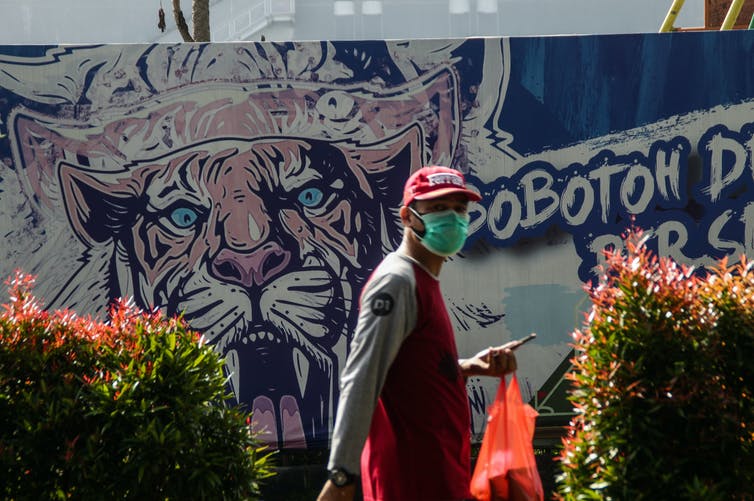Orientalism and the Advocacy of Face Masks

In September 1957, the New Yorker published an article called “Orientals are Stoic.” The author, Andre M. Tao-Kim-Hai, was a Vietnamese diplomat working for the United Nations. He described his experiences after surgery in a New York hospital and how he was constantly stereotyped by the medical and nursing staff:-
I decided that by “stoic” he meant tough (…) and I took it to be a compliment. But I wondered about “Orientals” and asked him for his interpretation of the word.
“Chinese, of course,” he said.
I asked him if he thought the whole Orient – whatever geographical limits he gave to that word – was peopled by Chinese. To my astonishment, he said that he took it for granted that I was Chinese, and anyway all yellow people were the same. I asked him if he thought all white people were the same…’
Tao went on to tell the interns how he had been hired by Canadian TV to read some French for a film soundtrack. At the end, the producer had complained that his accent was too French – he had spent more than 20 years living in France. Could he not read the text in an Oriental accent? “Which Oriental accent?” Tao replied – and explained that there were dozens of languages in India, as well as Japanese, Chinese, Laotian, Cambodian, Malay, Siamese, Burmese and whatever they spoke in Afghanistan, Tibet and Inner or Outer Mongolia. The interns switched to religion, where the author enlightened them on the differences between Taoism, Confucianism and Buddhism – and why none of these was a religion in the Western sense, and food, where he described the different culinary traditions of Japan, Korea, Indonesia and Siam…
Almost 70 years later, it would be nice to think that the biomedical and public health elites in the UK and North America thought in a more nuanced way about the “Orient,” not least because of the wide influence of Edward Said’s critique of such thinking. We should, however, be used to disappointment when it comes to pandemic measures. For some time before 2020, and certainly afterwards, there has been a regular chorus of complaints about how British and American people just will not wear face masks in the winter, like “the Asians” do.
Set aside the question of whether community use of face masks does impact on the transmission of respiratory viruses. What is going on here? Public health and biomedical leaders have plucked a single intervention out of its social, historical and cultural contexts and urged it upon recalcitrant British and American populations.
What, of course, is missing is any sense of those contexts. Historians, sociologists and anthropologists tend to work on slow publication schedules. However, East Asian Science, Technology and Society: An International Journal has published the papers from a forum of regional specialists convened in late summer 2020 to discuss “The Socio-Material History of Masked Societies in East Asia.”
One contributor, historian Akihisa Setoguchi, notes that the question “why Asians do wear masks” is vague, and its culturalist answers are unverifiable. It reproduces Orientalism by treating Asia as if it were a single entity sharing a homogenous culture and uniform history. The diverse stories of the artifact, science, culture, politics, and society that have shaped mask-wearing by region and country are invisible. The forum’s participants challenged this traditional narrative by tracing the varied national histories of mask-wearing.
Much of the value of this collection of papers lies precisely in its diversity. As the Japanese sociologist, Mitsutoshi Horii, observed in earlier publications, mask-wearing has significant ritual elements. It is bound up with notions of gender and modernity, and experiences of colonial medicine. In China, masks should be considered alongside the history of the handkerchief and attempts to eradicate traditional practices of nose clearing and spitting as part of strategies for the control of tuberculosis. At different times and places, masks might be worn for the supposed protection of others or as personal protection from others.
The studies of contemporary South Korea, Taiwan and Singapore discuss how masks were reworked from previous usage into new, and different, technological systems in the governance response to the COVID pandemic. In Japan, on the other hand, there has been little involvement of government in presenting masks as a tool of public health policy. This systemic approach also underlines the ways in which masks form part of packages of interventions, including quarantines and disinfection, that complicate any assessment of impact. As the editors stress, the striking thing about face masks is their diversity of functions rather than their homogeneity.
As these careful empirical studies emerge, they should prompt new questions about the Orientalism of British and American public health and biomedical elites – and about their networks with scientists in various Asian countries. When our leaders declare with confidence that they are assured of the effectiveness of masks as public health interventions, what socio-material network is at play here? Is it comparable to the story of the development economist flying out of Peru who asked the pilot to make another circuit over Lima because he was short of material for his book? Surely public health policies should be based on something more than scientific tourism and chats with “locals”?
A concern for Orientalist thinking should also lead us to ask what British and American elites are doing with their representation of this imagined “Asia.” Is this coded advocacy of a society where populations are more docile and deferential to elite pronouncements, whether from the ‘left’ or the ‘right’? Some leading medical sociologists and behavioral scientists are indistinguishable in this respect from senior figures in public health agencies or the honored scientists in research-intensive universities. Eminence-based declarations define ‘social justice’ as much as ‘population control.’
History and the social sciences have played little part in COVID pandemic management. This is another illustration of the costs that come with that exclusion.


























































































